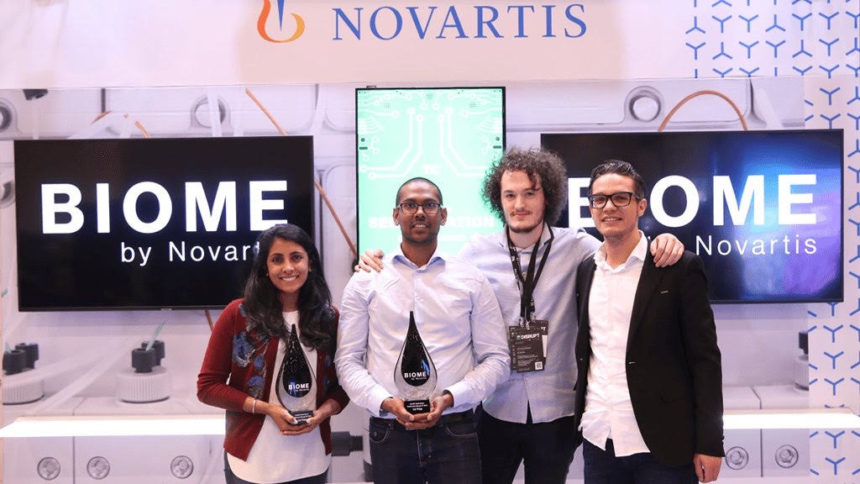Pharma hasn’t traditionally been known as a sector that welcomed innovation from the outside. But now companies are putting “not invented here” bias aside as they seek to widen their aperture for innovation.
This month saw the launch of two open innovation initiatives by drugmakers. Novartis opened the first of a series of planned innovation labs, this one in San Francisco, as part of a larger project to collaborate with startups and tech companies to fuel innovation. Novo Nordisk kicked off an innovation challenge, asking startups to create digital tools to help manage diabetes.
And they’re not alone. Pharma giants like Bayer and Johnson & Johnson also use open innovation, including accelerators, challenges, grants, and co-development, to find solutions to health problems. Meanwhile, the Department of Health and Human Services and American Society of Nephrology say they plan to launch KidneyX, an accelerator to rethink dialysis, in late October. Even companies that don’t traditionally work in healthcare, like Amazon, have held health-related open innovation activities.
It’s a sign of things to come. More than three-quarters (77%) of healthcare industry organizations are developing an “open innovation” competency, according to a recently released report on the trend of companies looking beyond their walls for new ideas. That compares with 59% of respondents from all industries.
Healthcare is clearly experimenting with this trend, but the companies still lag behind in mature open innovation competencies. Only 9% of healthcare organizations said they had a mature group, compared to 26% of companies from all industries.
Indeed, it’s still early days, but in five years, the hackathons, innovation challenges, and accelerators may be even more common. What’s more, instead of the healthcare industry lagging behind, like it did in digital in the 1990s, many health organizations from pharma to government agencies, are leading the embrace of open innovation.
“Whereas health was considered the laggard in digital, I do think in the last five to 10 years there’s been a period of heavy experimentation,” said Sara Holoubek, CEO of Luminary Labs, the consultancy which issued the report. “It’s not your agency building these tools anymore, it’s a very concerted effort to participate in [in open innovation]. You might have strange bedfellows.”
Holoubek said she sees parallels between healthcare’s newfound openness and the shift to a value-based care model, as well as to the fact that healthcare is increasingly in the public eye. Given these trends, the old way of doing business simply didn’t work anymore.
“The historic models of R&D, where everything is conducted under lock and key, are changing and pharma is starting to open in different ways,” she explained. “It’s about 15 years into an effort to move to a value-based model that required rethinking every part of our business. We’ve seen the rise of health tech and how data from these devices might change the industry.”
According to the report, healthcare companies are using open innovation for multiple goals, including to stimulate concept generation (68%), to position their organizations as innovators (64%), and to spark development of viable solutions or products (64%).
In the case of Novartis, the Swiss drugmaker plans to open several other innovation labs around the world as part of a company run innovation initiative called Biome, which gives startups access to guidance, mentorship, expertise, and/or de-identified data. The first cohort of tech companies its new San Francisco lab is working with includes Silicon Valley startups Medable and Mekonos.
Last month Novartis also launched the HealthX World Series, a series of open innovation challenges designed to tap into the health-tech ecosystem to find solutions to healthcare challenges. The first of these was a “global virtual hackathon challenge” at the TechCrunch Disrupt event, at which two startups—digital health firms Veta Health and Wavy—walked away with cash prizes and membership in Biome for their winning solutions designed to empower patients with heart failure.
While the presence of open innovation has been increasing in recent years, Holoubek said many companies still need to work on making it “part of their DNA.”
“These are still seen as flashy activities,” she said. “We will have to move from one-off challenges, hackathons, and data efforts to more thoughtful programs and competencies. It’s about seeing open innovation almost like digital. It becomes the way to do things and not just a flashy thing.”
Across all industries, the survey respondents identified time, funding, and internal goal alignment as the the top three barriers to open innovation. The solution, Holoubek said, is to “avoid shiny object syndrome.” Open innovation needs to be tied to an organization’s goals in order to convince company leaders to invest the time and money into it, she said.
As it grows, job titles dedicated solely to open innovation are popping up. For all industries, 38% of companies have a role solely focused on this, while 27% of health industry respondents had one, the report found.
With this steady rate of organizations embracing open innovation, Holoubek believes in the next five years there will be a “critical mass” of organizations with mature teams dedicated to the function.
“That’s why we draw that analogy between open innovation and the digital transformation,” she said. “There was one person, maybe two, who knew how to make a website [in the 1990s]. Open innovation is very much going through those same growing pains. It doesn’t happen overnight.”
This article has been updated to include additional data to clarify open innovation competencies in healthcare.







